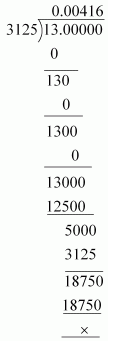NCERT Solutions Class 10 Maths
Chapter – 1 (Real Numbers)
The NCERT Solutions in English Language for Class 10 Mathematics Chapter – 1 Real Numbers Exercise 1.4 has been provided here to help the students in solving the questions from this exercise.
Chapter : 1 Real Numbers
- NCERT Class 10 Maths Solution Ex – 1.1
- NCERT Class 10 Maths Solution Ex – 1.2
- NCERT Class 10 Maths Solution Ex – 1.3
Exercise – 1.4
1. Without actually performing the long division, state whether the following rational numbers will have a terminating decimal expansion or a non-terminating repeating decimal expansion:

Solutions –
(i)
Factorizing the denominator, we get,
3125 = 5 × 5 × 5 × 5 × 5 = 55
The denominator is of the form 5m.
Hence, the decimal expansion of is terminating.
(ii)
Factorizing the denominator, we get,
8 = 2 × 2 × 2 = 23
The denominator is of the form 2m.
Hence, the decimal expansion of is terminating.
(iii)
Factorizing the denominator, we get,
455 = 5 × 7 × 13
Since, the denominator is not in the form of 2m × 5n, thus has a non-terminating decimal expansion.
(iv)
Factorizing the denominator, we get,
1600 = 2 × 2 × 2 × 2 × 2 × 2 × 5 × 5 = 26 × 52
Since, the denominator is in the form of 2m × 5n, thus has a terminating decimal expansion.
(v)
Factorizing the denominator, we get,
343 = 7 × 7 × 7 = 73
Since, the denominator is not in the form of 2m × 5n thus has a non-terminating decimal expansion.
(vi)
Clearly, the denominator is in the form of 2m × 5n.
Hence, has a terminating decimal expansion.
(vii)
As you can see, the denominator is not in the form of 2m × 5n.
Hence, has a non-terminating decimal expansion.
(viii)
Since, the denominator has only 5 as its factor, thus, has a terminating decimal expansion.
(ix)
Factorising the denominator, we get,
10 = 2 × 5
Since, the denominator is in the form of 2m × 5n thus, has a terminating decimal expansion.
(x)
=
Factorising the denominator, we get,
30 = 2 × 3 × 5
As you can see, the denominator is not in the form of 2m × 5n.
Hence, has a non-terminating decimal expansion.
2. Write down the decimal expansions of those rational numbers in Question 1 above which have terminating decimal expansions.
Solutions –
(i)

= 0.00416
(ii)

= 2.125
(iii) has a non terminating decimal expansion
(iv)

= 0.009375
(v) has a non terminating decimal expansion
(vi) =

= 0.115
(vii) has a non terminating decimal expansion
(viii) =
![]()
= 0.4
(ix)

= 0.7
(x) has a non-terminating decimal expansion.
3. The following real numbers have decimal expansions as given below. In each case, decide whether they are rational or not. If they are rational, and of the form, p q what can you say about the prime factors of q?
(i) 43.123456789
(ii) 0.120120012000120000. . .
(iii) 43.
Solutions –
(i) 43.123456789
Since it has a terminating decimal expansion, it is a rational number in the form of p/q and q has factors of 2 and 5 only.
(ii) 0.120120012000120000 . . .
Since, it has non-terminating and non- repeating decimal expansion, it is an irrational number.
(iii) 43.
Since it has non-terminating but repeating decimal expansion, it is a rational number in the form of p/q and q has factors other than 2 and 5.

